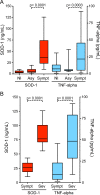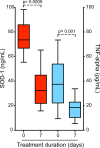Plasma superoxide dismutase-1 as a surrogate marker of vivax malaria severity
- PMID: 20386593
- PMCID: PMC2850307
- DOI: 10.1371/journal.pntd.0000650
Plasma superoxide dismutase-1 as a surrogate marker of vivax malaria severity
Abstract
Background: Severe outcomes have been described for both Plasmodium falciparum and P. vivax infections. The identification of sensitive and reliable markers of disease severity is fundamental to improving patient care. An intense pro-inflammatory response with oxidative stress and production of reactive oxygen species is present in malaria. Inflammatory cytokines such as tumor necrosis factor-alpha (TNF-alpha) and antioxidant agents such as superoxide dismutase-1 (SOD-1) are likely candidate biomarkers for disease severity. Here we tested whether plasma levels of SOD-1 could serve as a biomarker of severe vivax malaria.
Methodology/principal findings: Plasma samples were obtained from residents of the Brazilian Amazon with a high risk for P. vivax transmission. Malaria diagnosis was made by both microscopy and nested PCR. A total of 219 individuals were enrolled: non-infected volunteers (n = 90) and individuals with vivax malaria: asymptomatic (n = 60), mild (n = 50) and severe infection (n = 19). SOD-1 was directly associated with parasitaemia, plasma creatinine and alanine amino-transaminase levels, while TNF-alpha correlated only with the later enzyme. The predictive power of SOD-1 and TNF-alpha levels was compared. SOD-1 protein levels were more effective at predicting vivax malaria severity than TNF-alpha. For discrimination of mild infection, elevated SOD-1 levels showed greater sensitivity than TNF-alpha (76% vs. 30% respectively; p<0.0001), with higher specificity (100% vs. 97%; p<0.0001). In predicting severe vivax malaria, SOD-1 levels exhibited higher sensitivity than TNF-alpha (80% vs. 56%, respectively; p<0.0001; likelihood ratio: 7.45 vs. 3.14; p<0.0001). Neither SOD-1 nor TNF-alpha could discriminate P. vivax infections from those caused by P. falciparum.
Conclusion: SOD-1 is a powerful predictor of disease severity in individuals with different clinical presentations of vivax malaria.
Conflict of interest statement
The authors have declared that no competing interests exist.
Figures





Similar articles
-
Networking the host immune response in Plasmodium vivax malaria.Malar J. 2013 Feb 21;12:69. doi: 10.1186/1475-2875-12-69. Malar J. 2013. PMID: 23433077 Free PMC article.
-
Severe Plasmodium vivax malaria exhibits marked inflammatory imbalance.Malar J. 2010 Jan 13;9:13. doi: 10.1186/1475-2875-9-13. Malar J. 2010. PMID: 20070895 Free PMC article.
-
Biomarkers of disease severity in vivax malaria.Parasitol Res. 2021 Apr;120(4):1437-1446. doi: 10.1007/s00436-021-07065-3. Epub 2021 Feb 3. Parasitol Res. 2021. PMID: 33532947
-
A large proportion of asymptomatic Plasmodium infections with low and sub-microscopic parasite densities in the low transmission setting of Temotu Province, Solomon Islands: challenges for malaria diagnostics in an elimination setting.Malar J. 2010 Sep 7;9:254. doi: 10.1186/1475-2875-9-254. Malar J. 2010. PMID: 20822506 Free PMC article.
-
Cytokine balance in human malaria: does Plasmodium vivax elicit more inflammatory responses than Plasmodium falciparum?PLoS One. 2012;7(9):e44394. doi: 10.1371/journal.pone.0044394. Epub 2012 Sep 4. PLoS One. 2012. PMID: 22973442 Free PMC article.
Cited by
-
Distinct inflammatory profile underlies pathological increases in creatinine levels associated with Plasmodium vivax malaria clinical severity.PLoS Negl Trop Dis. 2018 Mar 29;12(3):e0006306. doi: 10.1371/journal.pntd.0006306. eCollection 2018 Mar. PLoS Negl Trop Dis. 2018. PMID: 29596409 Free PMC article.
-
Epidemiology, drug resistance, and pathophysiology of Plasmodium vivax malaria.J Vector Borne Dis. 2018 Jan-Mar;55(1):1-8. doi: 10.4103/0972-9062.234620. J Vector Borne Dis. 2018. PMID: 29916441 Free PMC article. Review.
-
Plasma circulating nucleic acids levels increase according to the morbidity of Plasmodium vivax malaria.PLoS One. 2011;6(5):e19842. doi: 10.1371/journal.pone.0019842. Epub 2011 May 17. PLoS One. 2011. PMID: 21611202 Free PMC article.
-
Understanding the clinical spectrum of complicated Plasmodium vivax malaria: a systematic review on the contributions of the Brazilian literature.Malar J. 2012 Jan 9;11:12. doi: 10.1186/1475-2875-11-12. Malar J. 2012. PMID: 22230294 Free PMC article.
-
Networking the host immune response in Plasmodium vivax malaria.Malar J. 2013 Feb 21;12:69. doi: 10.1186/1475-2875-12-69. Malar J. 2013. PMID: 23433077 Free PMC article.
References
-
- Kern P, Hemmer CJ, Van Damme J, Gruss HJ, Dietrich M. Elevated tumor necrosis factor alpha and interleukin-6 serum levels as markers for complicated Plasmodium falciparum malaria. Am J Med. 1989;87:139–143. - PubMed
-
- Karunaweera ND, Wijesekera SK, Wanasekera D, Mendis KN, Carter R. The paroxysm of Plasmodium vivax malaria. Trends Parasitol. 2003;19:188–193. - PubMed
-
- Delmas-Beauvieux MC, Peuchant E, Dumon MF, Receveur MC, Le Bras M, et al. Relationship between red blood cell antioxidant enzymatic system status and lipoperoxidation during the acute phase of malaria. Clin Biochem. 1995;28:163–169. - PubMed
Publication types
MeSH terms
Substances
LinkOut - more resources
Full Text Sources
Miscellaneous

